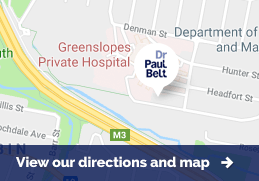The Procedure
A facelift is a rejuvenation procedure performed on the cheeks, jowl region and neck.
The facelift may also be performed in concert with surgery on the brow, eyelids and neck. Other adjuvant procedures include liposuction to the jowl and neck, Coleman fat transfer or fillers and anti-wrinkle injections to reduce the wrinkle lines between the eyebrows, the forehead and around the eyes.
Dr Belt frequently uses the MACS facelift which is an advancement of the previous S lift. A MACS facelift (Minimal Access Cranial Suspension) uses a much shorter incision and produces less scarring, The scar starts at the earlobe and runs in he skin crease in front of the ear and at the transition of the skin and hairline in the temple.
There are essentially two types of MACS facelift.
The simple MACS facelift involves the placement of two sutures within the SMAS layer of the face.
The first is placed from the zygomatic region of the cheek to the angle of the jaw and corrects the excess droop and loss of tone in the neck. This results in a correction of the angle under the neck and restores a more defined neck and jawline.
The second suture is placed further medially (towards the nose) from the ear in the zygomatic region and uses a “purse string” effect to correct and lift the jowl area. This reverses the tell-tale ageing and descent that is seen in this area for the face.
An extended MACS facelift uses the same two sutures as the simple MACS facelift but in addition it also employs a third suture which is placed under the lower eyelid below the outer corner of the eye and extends down on to the malar fat pad region.
This latter suture will correct the droop and descent of the lower eyelid and results in a powerful restoration of volume to the mid face.
This produces a more youthful “Ogee” contour to the malar or cheekbone region. Excess skin generated with this third suture will require a small lower eyelid pinch blepharoplasty to correct the small puckering of the skin caused by the placement of this suture.
Once these sutures have been placed in the SMAS layer of the face, the lift creates a small (usually 3cm) of excess skin. This is excised in an anti-gravitational manner so that the skin is lifted in a pure vertical vector. There is no “pullback” effect, which would tend to flatten the face. This affects a lift to the face in the reverse manner in which age has lowered the tissues. It avoids the “wind tunnel” look, which is a classic stigma of some traditional facelifts.
A MACS facelift is always performed in combination with liposuction to the submental (under the chin) area. The reason for this is that it removes any fat in that area. This region of the neck is then pulled and lifted into the face and would produce abnormal contour if this area were not thinned appropriately. The submental liposuction also helps to create a suitable plane to allow release and subsequent elevation of the facial skin.
Neck Lift
A facelift will also produce a lift and an improvement in the contour of the neck. Additional procedures can also be performed on the neck to enhance the lifting produced by a facelift (e.g. a posterior cervicoplasty) at the time of the facelift procedure. It is also possible for an isolated lift to be performed on the neck without a facelift. Dr Belt is happy to advise which of these procedures would be appropriate for you to achieve your desired results.

Complications and Risks
All Procedures have potential complications and risks. These can be divided into general complications and those specific to each procedure. The latter are listed in the FAQs below.
General complications include:
- Wound complications - bleeding, bruising, collections under the skin of blood (haematoma), pus (abscess), serous fluid (seroma), infection, wound breakdown, suture extrusion, sensory loss;
- Aesthetic complications - poor scars, stretched scars, raised scars (keloid or hypertrophic), contour irregularities, need for revisional procedure;
- Anaesthetic complications
FAQs
-
How is the operation performed?
The operation is usually performed as an inpatient procedure under general anaesthetic. It is possible to perform some procedures under sedation and local anaesthetic. Most patients only stay one night and day case procedures are possible.
An incision is made in front of the ear, extending into the hairline and behind the ear. The strong connective tissue layer under the skin is tightened to reduce the redundancy of this layer. Excess redundant skin is then excised. In a MACS facelift a shorter incision and more limited undermining may be employed.
-
Is it possible to perform a smaller operation?
There are a number of alternative smaller facelifting operations that produce excellent results in some patients. Not all patients are suitable for these procedures. These alternative techniques involve shorter incisions, less extensive skin undermining and different techniques to redrape the connective tissue layer.
The MACS lift involves a short incision in front of the ear, extending a few cm into the temporal hairline. The skin is undermined to a lesser extent. The connective tissue is suspended from the thick tissue in the temple by 2 or 3 stitches on each side. The recovery time is much shorter - usually only one week. This technique is particularly powerful at addressing the jowl area and redundant folds of skin in the neck.
-
Is the surgery permanent?
The surgery will produce a lasting result, however it cannot halt the ageing process. It has been stated that “ You can turn back the clock, but you can’t stop it ticking.” You will always remain more youthful than without the surgery.
-
What are the risks of the surgery?
The risks will be discussed with you in detail before you consent to the operation. The risks can be broken down into general risks associated with any operation, and those specific to facelifting surgery.
General operative risks include anaesthetic complications, bruising, bleeding, infection, wound breakdown and abnormal scarring.
Specific complications include visible scars, collections of blood under the skin (haematoma), wound breakdown, poor healing, skin loss (necrosis), hair loss within and around the scars (alopecia), deformity of the earlobe, temporary numbness of the cheek and ear, damage to the underlying facial nerve which can produce some muscle weakness, asymmetry and disappointment with the final cosmetic result in terms of extent of improvement and final contour of the neck and face.
-
What can I expect after the operation?
A drain will be placed under the skin on each side. These will be removed on the morning after surgery. Your face will be dressed in a tailor-made support garment which you are encouraged to wear as much as possible for the first week. This garment can easily be removed and replaced by the patient.
Stitches placed in the skin incisions are removed at day five. A degree of swelling and bruising will be noticeable for at least a week.
-
What Costs are involved?
- Dr Belt’s surgical fee
- Assistant’s fee
- Theatre fee / day bed, and overnight bed if not a day case
- Specialist anaesthetist’s fee
-
Is it possible to perform other procedures at the same time?
A MACS facelift is commonly performed with other facial rejuvenation procedures including an upper and lower eyelid blepharoplasty, fillers, Coleman fat transfer to the perioral region as well as a neck lift. Classic facelifts don’t fill the nasolabial folds or marionette lines although they can lift the adjacent tissues. The use of fillers (autologous or artificial) is a useful adjunctive procedure to compliment the aesthetic results of a facelift.














